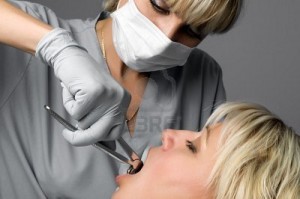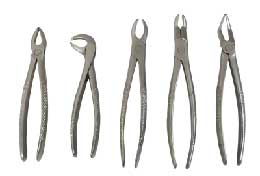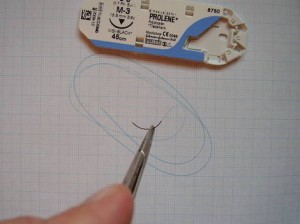As with any other dental procedures, teeth extraction required specific dental instruments to do so. Unlike our baby teeth which could be easily pulled out when they are wobbly or would naturally drop off in their due times, adult teeth are a different matter altogether. Because of their longer root length and stronger surrounding supporting tissues, adult or permanent teeth (or even baby teeth that are not loose) would require certain techniques and dental tools to remove them.
Extraction forceps
Tooth extraction forceps come in numerous shapes and sizes. The choice of forceps is largely down to the dentist’s preference or more frequently, availability. Forceps are designed with relatively short blades and long handles to offer a larger mechanical advantage. Most forceps come with a primary or baby tooth equivalent.
Types of forceps
Upper forceps have their handles in line with the blades while lower forceps have their handles at right angles to the blade. Blades vary in width, length and curvature to accommodate the different shapes of the roots.
- Straight forceps – are simplest in design and are suitable for the front teeth (incisors and canines).
- Upper premolar forceps – have handles that are angled in a mesial direction relative to the blades, thus allowing correct alignment of the blades for the premolar tooth. The curvature is to avoid the handles from fouling the lower lip or teeth.
- Lower root forceps – all lower forceps are angled with their handles at roughly 90 degrees from the blades. The handles sit in an axial plane. This allows the optimum position of the dentist’s hand for both power and control.
- Lower molar forceps – the lower molar has two mesial roots which are fused and one distal root. Most lower molars show two roots when viewed from the sides. Therefore the forceps will need a twin beak on either side. Third molar or wisdom tooth has variable root pattern.
- Upper molar forceps – upper molar teeth has three roots (two buccal roots and one palatal root). The forceps are twin beaked on the buccal or cheek side and have a single blade palatally. Because of the asymmetrical beaks, the instrument is not reversible and separate beaks are needed for right and left.
- Bayonet forceps – upper third molars may require forceps with additional distal reach. Bayonet forceps has blades offset substantially in a distal direction for this purpose. The shape resembles a bayonet rifle attachment.
- Cowhorns forceps – are designed to penetrate in between the roots of molars to split the roots especially if the roots are diverged. .
Elevators
Elevators have three components – handle, shank and blade. Elevators differ from the forceps in the manner in which force is applied. The elevator applies force between the tooth and the bone so force is not transmitted to the jaw. Elevators exert less directional force on the tooth so tooth is less likely to fracture.
Elevators can be used along with forceps to:
- breakdown the attachment of the tissues supporting the tooth,
- expanding the bony socket to facilitate dental tooth extraction,
- allow excess for the forceps to grip further down the root,
- remove root stumps.
These are the instruments which should always be used to remove impacted teeth. They should be used with gentle (finger pressure) forces. The commonly used patterns are Couplands No. 1, 2 and 3, Cryers right and left and Warwick-James right, left and straight.
Scalpel
A Bard-Parker handle with a No. 15 blade is the usual scalpel used to make incisions on the gums where a flap can be raised to gain access to tooth.
Periosteal elevators
A number are available and are similarly used like a normal elevator but periosteal elevators have two heads – one at each end. One end is sharp-tipped to expand the tooth socket while the other has a blunt end to remove granulation tissues or raise a gum flap.
Retractors
Tongue, cheek and flap retractors are needed to provide adequate access to the tooth and are legion in number.
Surgical burs
Used with a straight hand piece, burs are used to remove bone surrounding the tooth to be extracted or to split the tooth apart. Generally burs are kinder on the conscious patient.
Chisels and mallet
Chisels are more appropriate in the operating theatre and are particularly useful for disto-angular third molars and upper wisdom teeth extraction.
Bone curettes
The Mitchells trimmer is probably the most valuable instrument in the category and is used to remove granulation tissue in the tooth socket.
Bone ronguer and bone file
Used to smoothen any sharp bone edges after tooth extraction is done.
Needle holders and sutures
Sutures are used to replace and secure the gum flap in its former position, to limit the size of the wound and therefore restrict subsequent contamination with food debris, and to assist in controlling bleeding. The usual suture size for intra-oral work is 4/0 and the material may be absorbable or non-absorbable
Scissors
Dissecting scissors and suture-cutting scissors are usually used.
Artery forceps
These are designed to hold soft tissue without damaging it. College tweezers are used to lift up sutures prior to removing them.
Aspirator
Sterile or disposable suction tip small enough to get into the defect are used to aspirate blood or saliva.





thanks